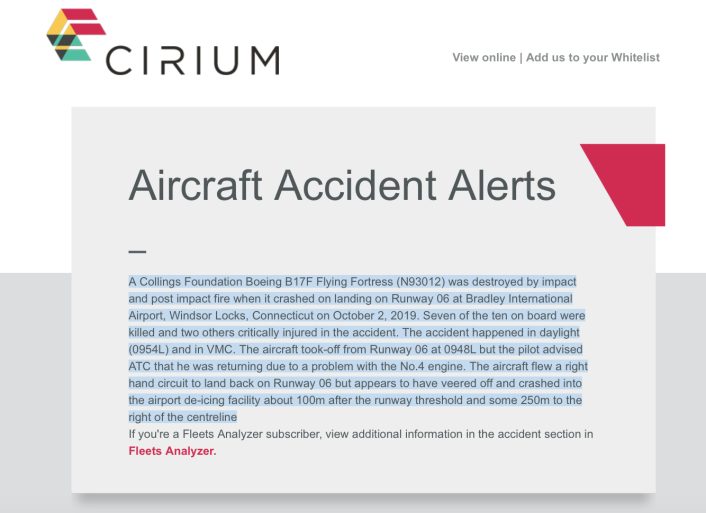Death Toll Rises as FAA Investigation into The Historic Bomber Accident Begins.
New details are emerging about the fatal crash of the B-17G Flying Fortress named “Nine-O-Nine” at Bradley International Airport in Windsor Locks, Connecticut, at approximately 10:00 AM local time on Wednesday.
On Thursday, Oct. 3, 2019, the Connecticut State Police released the names of the seven people killed in the crash on Wednesday. The victims are: Ernest McCauley, 75 – Pilot, from Long Beach, California; Michael Foster, 71 – Co-Pilot, from Jacksonville, Florida; David Broderick, 56 – passenger from West Springfield, Massachusetts; Gary Mazzone, 66, – passenger from Broad Brook, Connecticut; James Roberts, 48 – passenger from Ludlow, Massachusetts, Robert Riddell, 59 – passenger from East Granby, Connecticut; and Robert Rubner, 64 – passenger from Tolland, Connecticut.
According to State Police, there were 13 people on board the B-17G Flying Fortress at the time of the crash. Three persons were crew members and 10 were passengers. Seven of the 13 on board did not survive the crash.
The six people listed as injured in the crash are: Mitchell Melton, 34 – Flight engineer on the B-17G, from Dalehaff, Texas; Andy Barrett, 36 – passenger from South Hadley, Massachusetts; Linda Schmidt, 62 – passenger from Suffield, Connecticut; Tom Schmidt, 62 – passenger from Suffield Connecticut; Joseph Huber, 48 – passenger from Tariffville, Connecticut; James Traficante, 54 – passenger from Simsbury, Connecticut.

While initial reports of injuries and fatalities in the accident were conflicting, A report from the authoritative aviation safety news outlet FlightGlobal.com released late on Wednesday, October 2, 2019 said that:
“A Collings Foundation B-17F Flying Fortress (N93012) was destroyed by impact and post impact fire when it crashed on landing on Runway 06 at Bradley International Airport, Windsor Locks, Connecticut on October 2, 2019. Seven of the ten on board were killed and two others critically injured in the accident. The accident happened in daylight (0954L) and in VMC. (Author’s Note: “VMC” or, “Visual Meteorological Conditions” is an aviation flight category in which Visual Flight Rules [VFR] flying is permitted. It indicates favorable weather conditions for visual flying without dependence on cockpit instruments). The aircraft took-off from Runway 06 at 0948L but the pilot advised ATC that he was returning due to a problem with the No.4 engine. The aircraft flew a right-hand circuit to land back on Runway 06 but appears to have veered off and crashed into the airport de-icing facility about 100m after the runway threshold and some 250m to the right of the centerline.”
The aircraft involved in the crash was one of only ten remaining flyable Boeing B-17 Flying Fortress bombers. While it was initially reported that the aircraft was a “G” model of the B-17, a subsequent report that appears to be incorrect says the aircraft in the crash, named the “Nine-O-Nine” with registration N93012, was a Boeing B-17F. The B-17F was the last version of the B-17 to be produced without a forward-facing chin turret mounted under the nose. The subsequent version, the later B-17G Flying Fortress, was equipped with a rotating, forward facing chin gun turret with two .50 caliber machine guns. All recent photos of B-17 Flying Fortress (N93012) “Nine-O-Nine” show this aircraft with a chin turret, suggesting it is, in fact, a B-17G version- not a B-17F as stated in the FlightGlobal.com report distributed via email from Cirium.com.

It is noteworthy that the aircraft “flew a right-hand circuit to land back on Runway 06” according to FlightGlobal.com when the pilot said over the radio moments before the crash, “Number 4 engine we’d like to return. Blew it out.” (Source: LiveATC.net). Most multi-engine aircraft reference their engine numbers from left to right. The B-17G has four engines, with engine No.1 being located on the outboard/left wing as viewed from the pilot’s position seated in the cockpit facing forward in the aircraft. This could suggest that the pilot’s reference to “Number 4 engine we’d like to return. Blew it out,” means that the aircraft could have turned into an engine that may have been experiencing problems delivering thrust. As with all aviation accidents however, the cause of the accident has not been determined yet and an investigation by the FAA is underway.

A news report from CBS News This Morning by CBS News Transportation Correspondent
Kris Van Cleave said that, “Runway 6, the NTSB is going to be looking very closely at it because that is where the plane came down before it veered to the right, eventually hitting a building.” Van Cleave went on to report that, “They landed short of the runway at Bradley, and crashed into a nearby de-icing facility and maintenance building.”
Historic aircraft in the U.S. such as this B-17G often carry media and paying passengers on flights for photo opportunities and to experience what flying on these historic aircraft is like. One of the passengers on board the B-17G “Nine-O-Nine” who died tragically in the crash was aviation enthusiast Robert Riddell of East Granby, Connecticut. According to a report on MassLive.com, “Prior to the flight, he posted on social media of his excitement to board the WWII B-17 Flying Fortress.”










